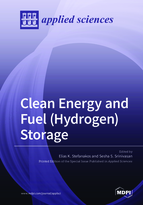Clean Energy and Fuel (Hydrogen) Storage
A special issue of Applied Sciences (ISSN 2076-3417). This special issue belongs to the section "Energy Science and Technology".
Deadline for manuscript submissions: closed (31 December 2018) | Viewed by 96121
Special Issue Editors
Interests: solar energy conversion (photovoltaics, rectennas, etc.); fuel cells; hydrogen production and storage; energy systems; electric/hybrid vehicles—alternative fuels; thermal storage; photocatalysis; electrochromic, touch-chromic and thermochromic materials
Special Issues, Collections and Topics in MDPI journals
Interests: hydrogen production; hydrogen storage; fuel cells; nanotechnology; multifunctional materials; photocatalysis; material synthesis and characterization
Special Issue Information
Dear Colleagues,
Clean energy and fuel storage is often required for both stationary and automotive applications. Some of these clean energy and fuel storage technologies, currently under extensive research and development, are hydrogen storage, direct electric storage, mechanical energy storage, solar-thermal energy storage, electrochemical (batteries), and thermochemical storage. The gravimetric and volumetric storage capacity, energy storage density, power output, operating temperature and pressure, cycle life, recyclability and cost of clean energy or fuel storage are some of the factors that govern efficient energy and fuel storage technologies for potential deployment in energy harvesting (solar and wind farms) stations and on-board vehicular transportation. This Special Issue, thus, serves the need to promote exploratory research and development on clean energy and fuel storage technologies while addressing their challenges to a practical and sustainable infrastructure. We invite contributions in topics that include but not limited to various state-of-the-art energy and alternative fuel storage technologies.
Prof. Dr. Elias K. Stefanakos
Dr. Sesha S. Srinivasan
Guest Editors
Manuscript Submission Information
Manuscripts should be submitted online at www.mdpi.com by registering and logging in to this website. Once you are registered, click here to go to the submission form. Manuscripts can be submitted until the deadline. All submissions that pass pre-check are peer-reviewed. Accepted papers will be published continuously in the journal (as soon as accepted) and will be listed together on the special issue website. Research articles, review articles as well as short communications are invited. For planned papers, a title and short abstract (about 100 words) can be sent to the Editorial Office for announcement on this website.
Submitted manuscripts should not have been published previously, nor be under consideration for publication elsewhere (except conference proceedings papers). All manuscripts are thoroughly refereed through a single-blind peer-review process. A guide for authors and other relevant information for submission of manuscripts is available on the Instructions for Authors page. Applied Sciences is an international peer-reviewed open access semimonthly journal published by MDPI.
Please visit the Instructions for Authors page before submitting a manuscript. The Article Processing Charge (APC) for publication in this open access journal is 2400 CHF (Swiss Francs). Submitted papers should be well formatted and use good English. Authors may use MDPI's English editing service prior to publication or during author revisions.
Keywords
-
Hydrogen Production and Storage
-
Thermal Energy Storage
-
Direct Electrical Energy Storage
-
Direct Mechanical Energy Storage
-
Electrochemical Energy Storage
-
Thermochemical Energy Storage
-
Other Clean Energy and Fuel Storage Options







